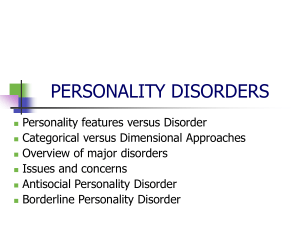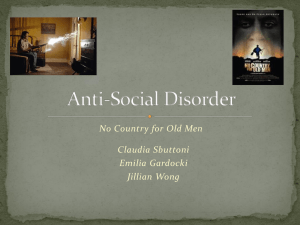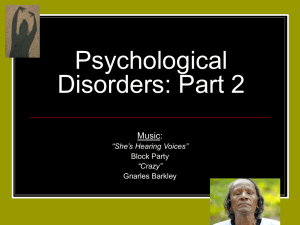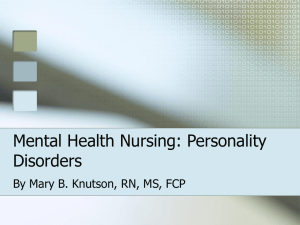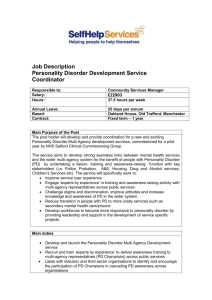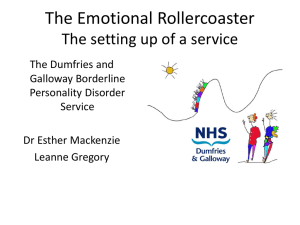Personality Disorders Note-Taking Outline
advertisement
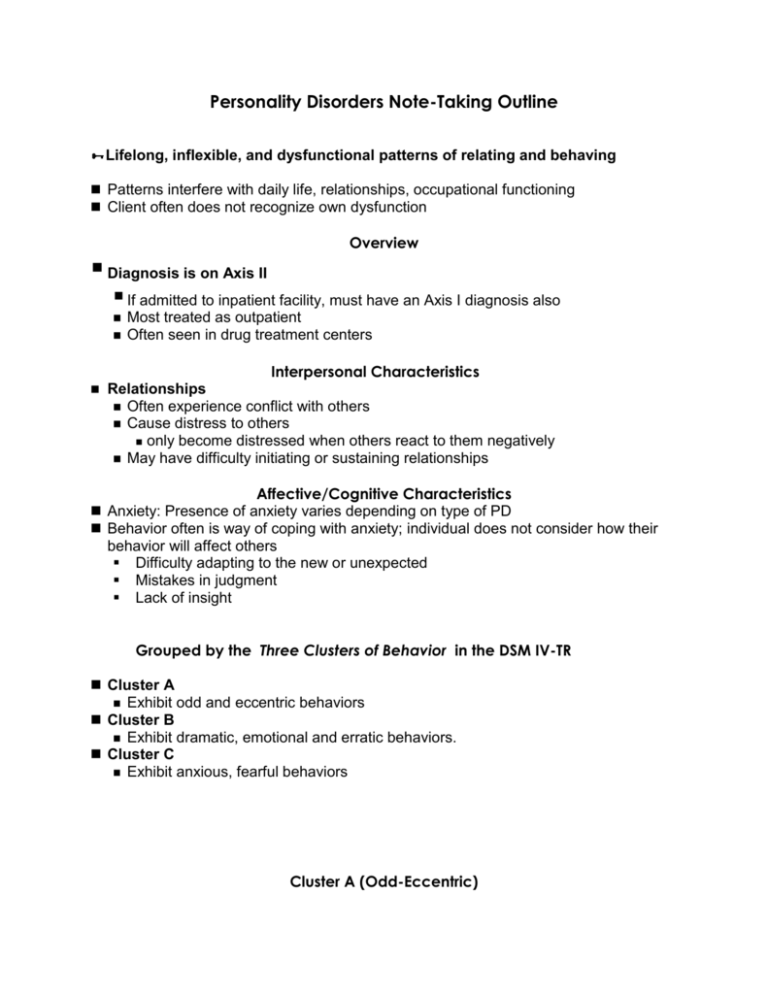
Personality Disorders Note-Taking Outline Lifelong, inflexible, and dysfunctional patterns of relating and behaving Patterns interfere with daily life, relationships, occupational functioning Client often does not recognize own dysfunction Diagnosis is on Axis II Overview If admitted to inpatient facility, must have an Axis I diagnosis also Most treated as outpatient Often seen in drug treatment centers Interpersonal Characteristics Relationships Often experience conflict with others Cause distress to others only become distressed when others react to them negatively May have difficulty initiating or sustaining relationships Affective/Cognitive Characteristics Anxiety: Presence of anxiety varies depending on type of PD Behavior often is way of coping with anxiety; individual does not consider how their behavior will affect others Difficulty adapting to the new or unexpected Mistakes in judgment Lack of insight Grouped by the Three Clusters of Behavior in the DSM IV-TR Cluster A Exhibit odd and eccentric behaviors Cluster B Exhibit dramatic, emotional and erratic behaviors. Cluster C Exhibit anxious, fearful behaviors Cluster A (Odd-Eccentric) Characteristics: odd, eccentric behavior, suspicious ideations, and social isolation. Know this cluster as a group (do not have to recognize each individually) Schizoid P.D. Schizotypal P.D. Paranoid P.D. Cluster A Overview Similarities to schizophrenia, but No fixed delusions or hallucinations May have transient psychotic symptoms when under acute stress May have biological family member with schizophrenia Cluster A Types: Schizoid PD-withdrawn, isolative, cannot relate to others Schizoptypal PD-odd, eccentric thoughts and behaviors Paranoid PD-suspicious, interprets hidden meanings, fearful, bears grudges Cluster A: Nurse-client Relationship Building trust is most important Be honest; keep it simple Do not intrude on privacy, if possible Do not challenge odd beliefs or appearance Expect inappropriate anger, hostility and altered interpretations of reality when pt.’s anxiety is high Cluster A: Milieu Do not push into social or group activities, but give gentle encouragement Choose groups that are non-threatening Cluster B (Dramatic, Emotional, Erratic) Characteristics: Impulsive, dramatic behavior, intolerance of frustration, exploitative interpersonal relationships. Narcissistic P.D. Histrionic P.D. Antisocial P.D. Borderline P.D Is most commonly dx’d. P.D. Cluster B Types Histrionic PD-wants to be center of attention, provocative, overreacts Narcissistic PD-needs to be admired, grandiose, sense of entitlement, takes advantage of others Interventions for Histrionic or Narcissistic P.D. Set appropriate limits Be consistent in approach Be matter-of-fact Focus on here-and-now Use supportive confrontation for discrepancies and contradictions Support self-esteem (does this seem like a contradiction?) Antisocial Personality Disorder (APD) Pattern of disregard of the rights of others Non-conforming to rules Often found in criminal justice system rather than in mental health services May seek hospitalization to avoid the law Antisocial Personality Disorder: Cognitive and Affective Aspects Low tolerance for frustration; cannot delay gratification of impulses Unable to make long-range plans Deny and rationalize behavior Little guilt or remorse May be aggressive, sexually inappropriate or abusive Antisocial Personality: Interpersonal Aspects May appear charming and confident Self-interest comes before needs of others Unable to sustain close personal relationships. Sex life is impersonal and impulsive. Antisocial Personality: Etiology Biological Genetic: inherited trait or predisposition ANS under-responds to stress Low activity in frontal lobe Unable to learn from rewards and punishment History of disordered life functioning Parent-child relationship often is unstable Childhood characteristics of lying, stealing and being truant. Client Profile: APD A 24 year old unemployed male was admitted from jail to the mental health unit after a suicide attempt in his cell. Was awaiting sentencing for burglary: stole from the apt. of his former girlfriend. States to the nurse that his problems started after she broke up with him. Client was using alcohol and cocaine heavily. Explains, “She owed me and so I took some cash and stuff.” The client has a distressed affect when discussing current situation. He states, “Now they’re putting a label of crazy on me.” DSM IV-TR Dx = Axis 1: Mood Disorder NOS, Polysubstance Abuse; Axis 2: Antisocial PD Antisocial Personality Disorder: Nursing/Milieu Interventions Essential for staff to agree on rules and stick with them Will try to play one staff or shift against another Set firm limits Point out effect of behavior on others Point out consequences of behavior Best form of treatment: Peer counseling and self-help groups like AA, where peers can confront and offer feedback Borderline Personality Disorder Overview Characterized by: Extremely intense and variable moods Disturbed sense of self; often self-negative Impulsivity, often with self-destructive behavior Use of “splitting” (also called “black or white thinking”) as defense mechanism Borderline Personality Disorder DSM IV-TR Criteria Fear of abandonment and frantic efforts to avoid it Unstable, intense relationships Marked identity disturbance Chronic feelings of emptiness Impulsivity that may be self-damaging When under stress may experience transient, paranoid thoughts or delusions, or dissociative symptoms Recurrent Self-Destructive Behavior Suicidal threats & gestures Self-Injurious Behavior (SIB) Affective instability Rapid mood shifts Low frustration tolerance Problems with anger Borderline PD: Etiology A predisposition plus childhood experiences is current accepted theory Childhood environment: often chaotic or neglectful Strong evidence for abuse, trauma history Neurobiological: (cause or result of stress?) Serotonin dysregulation cholinergic and adrenergic abnormalities lack of integration of right and left hemispheres smaller hippocampal volume Issues for Borderline Personality: Splitting Phenomenon Low tolerance for ambivalence Inability to cope with conflict Sense of inner emptiness Identity is obtained from other person Issues: Interpersonal Relationships Unstable and intense Characterized by over-idealizing or devaluation of others Cannot resolve feelings that others are not perfect and cannot meet all of their needs Fear being abandoned; may be needy and dependent Issues: Self-injury: (serves several functions) Is self-punishment Relieves tension Improves mood Is evidence that they are real, and can feel Suicide risk is high due to: Self-injuring behaviors Severe emotional pain Impulsivity BPD: Nurse-client Relationship Consistency, trust, honesty Explain and then Enforce unit rules matter-of-factly Team approach: Minimize splitting of staff Be accepting, convey empathy Discuss how to express and handle feelings Encourage self-responsibility and appropriate behaviors Offer choices, when possible Give positive feedback for accomplishments and progress Don’t get discouraged by “backsliding” Do not minimize or ignore SIB Client Profile: Borderline Personality A 27 year-old divorced female was admitted for severe mood swings & suicidal thoughts with a plan to overdose on pills and alcohol. The patient recently lost job due to excessive absences. Has unstable job history-frequently quits or is fired. Pt. uses marijuana episodically when depressed. Long history of outpt. tx. for depression and cutting self on legs. Identifies current stressors as financial issues, therapist leaving position at MH clinic. DSM IV-TR diagnoses: Axis I Major Depressive Episode; Axis II Borderline Personality Disorder Borderline Personality: Milieu Provide safe environment based on ongoing assessment; suicide or self-injury precautions prn Groups: Coping skills, Expressive Arts Journaling: Promotes safe identification of own thoughts, feelings and actions BPD: Community Resources Individual and group therapy with specialist: CBT and Dialectical Behavior Therapy (DBT) Family education and support; couples counseling: NAMI, Al-anon, etc. AA, NA, ACOA for substance abuse issues Cluster C: (Anxious-Fearful) Dependent Personality Disorder Pervasive, excessive need to be taken care of Fears being alone and helpless Unable to make decisions without much support Avoidant Personality Disorder Fears making mistakes, rejection Shyness and inadequacy Socially uncomfortable Obsessive-Compulsive Personality Disorder Perfectionistic and inflexible Preoccupied with details Too busy to have fun or friends Hoards objects and money Nursing Interventions for Cluster C Assist in setting small, achievable goals Assist to explore feelings Encourage and assist to try new activities Assist to decrease anxiety and need for perfection Cluster C: Milieu Management Groups: Assertiveness training, Stress management skills, Leisure skills Most clients seen as outpatients Personality Disorders Pharmacological Interventions Medications to address severe, disabling symptoms/distress Assess need for emergency, prn or short term medications when in crisis Examples: Suicidal behavior Transient psychosis Assaultive behavior Severe anxiety episode Treat co-morbid Axis I diagnoses: Depression, Anxiety Disorders, Bipolar Disorder, etc. Evaluation of Interventions What behaviors are targets for tx. within a short-term hospital stay? How can the nurse evaluate effectiveness of interventions for the person who has a personality disorder?
